Outdoor living spaces have become an extension of our homes. You can create a comfortable oasis to relax and entertain with the right outdoor furniture. Wood is one of the most popular and timeless outdoor furniture materials. Unlike metal or plastic, wood has a natural elegance and warmth that enhances any outdoor setting.
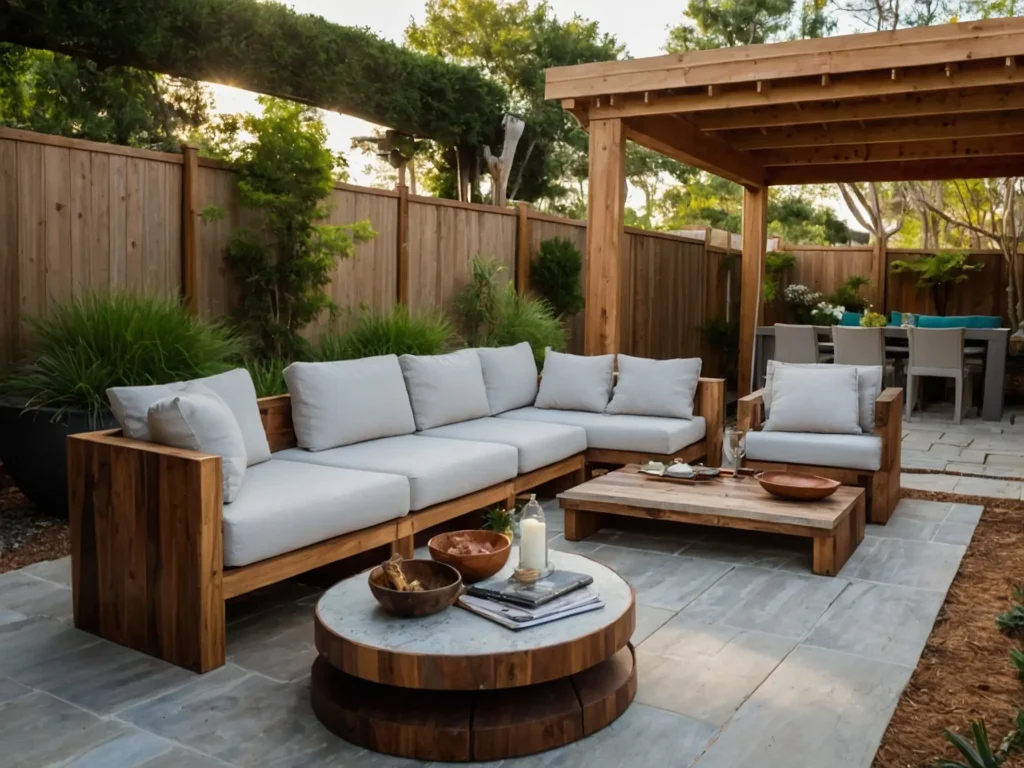
However, not all woods are suitable for outdoor use. When exposed to the elements, some are prone to rot, splitting, and deterioration. Choosing the right wood is crucial to ensure your furniture lasts for years. This guide will explore the ins and outs of selecting the best woods for outdoor furniture.
What Makes a Wood Ideal for Outdoor Use?
Several key factors determine how well a wood withstands the outdoors:
Weather Resistance
The best outdoor wood has natural oils, resins, and dense grain, making it resistant to rot, decay, and insect damage. Woods like teak, ipe, and cedar have exceptional weather resistance.
Durability
Hard, dense woods like mahogany and shorea are less prone to dents, scratches, and wear. Their density makes them durable outdoor choices.
Stability
Woods that resist checking, splitting, and warping are more stable outdoors. Stability ensures the furniture retains its structural integrity.
Aesthetics
While all woods have natural beauty, some are exceptionally striking. Rich color variations, interesting grain patterns, and the ability to age gracefully impact aesthetics.
By evaluating these factors, you can select a wood that will withstand the outdoors while retaining its beauty. Now let’s explore some of the best wood species for outdoor furniture.
The Gold Standard: Teak

Teak reigns supreme as the gold standard for outdoor furniture. Native to Southeast Asia, genuine teak has exceptional durability, weather resistance, stability, and rich aesthetics. Here’s a closer look at what makes teak so special:
Natural Weather Resistance
Teak has high levels of natural oils that make it resistant to moisture, mildew, insects, and rot. It’s perfect for any climate, from hot tropical regions to cold northern winters.
Long-Lasting Durability
A teak patio set can easily last 50-75 years or longer with proper care. The dense grain withstands dents and scratches better than other woods.
Low Maintenance
Although teak can be maintained with teak oil to retain its warm golden color, it doesn’t require much upkeep. Unfinished teak will develop a stately silver-gray patina over time.
Beautiful Aesthetics
Teak has a straight, even grain pattern ranging from light to dark golden brown. The rich color and grain patterns give it exceptional natural beauty.
Eco-Friendly Choice
Look for sustainably harvested teak from plantations rather than natural forests. This ensures the teak is eco-friendly.
While genuine teak commands a higher price, it’s a worthwhile long-term investment for unmatched quality.
More Affordable Teak Alternatives
For those seeking the look of teak at a lower cost, several woods provide a comparable appearance and performance:
Acacia
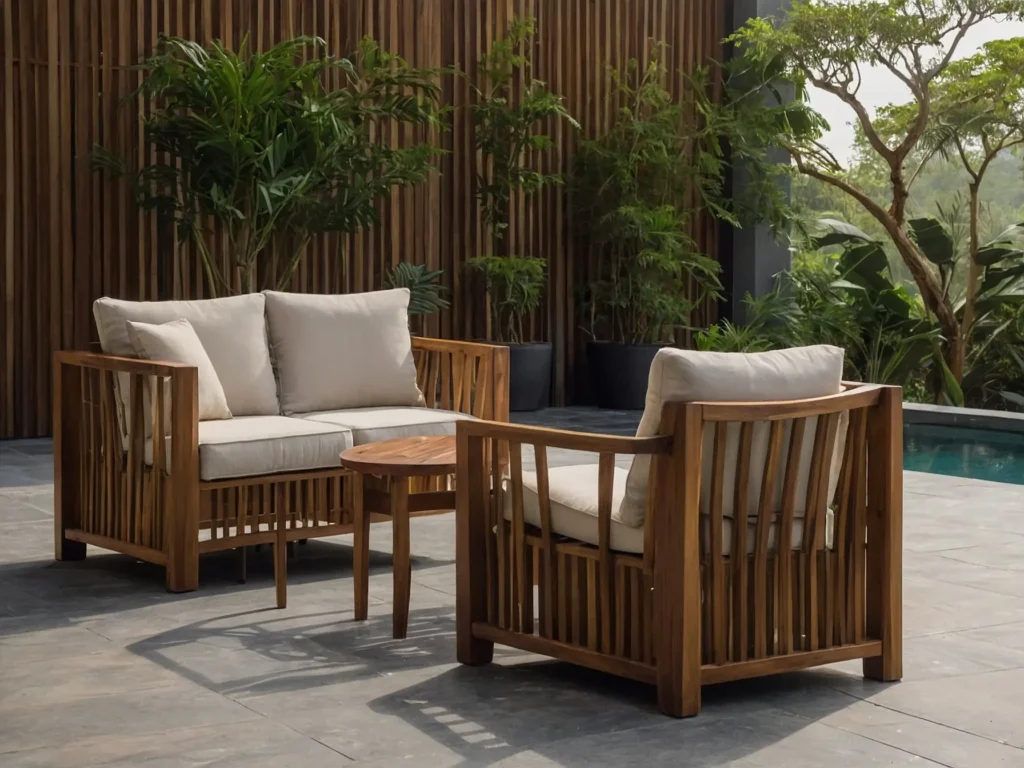
Acacia, also called acoya wood, has a similar grain pattern to teak. It’s strong, durable, and attractive. Look for sustainable plantations to source acacia.
Eucalyptus
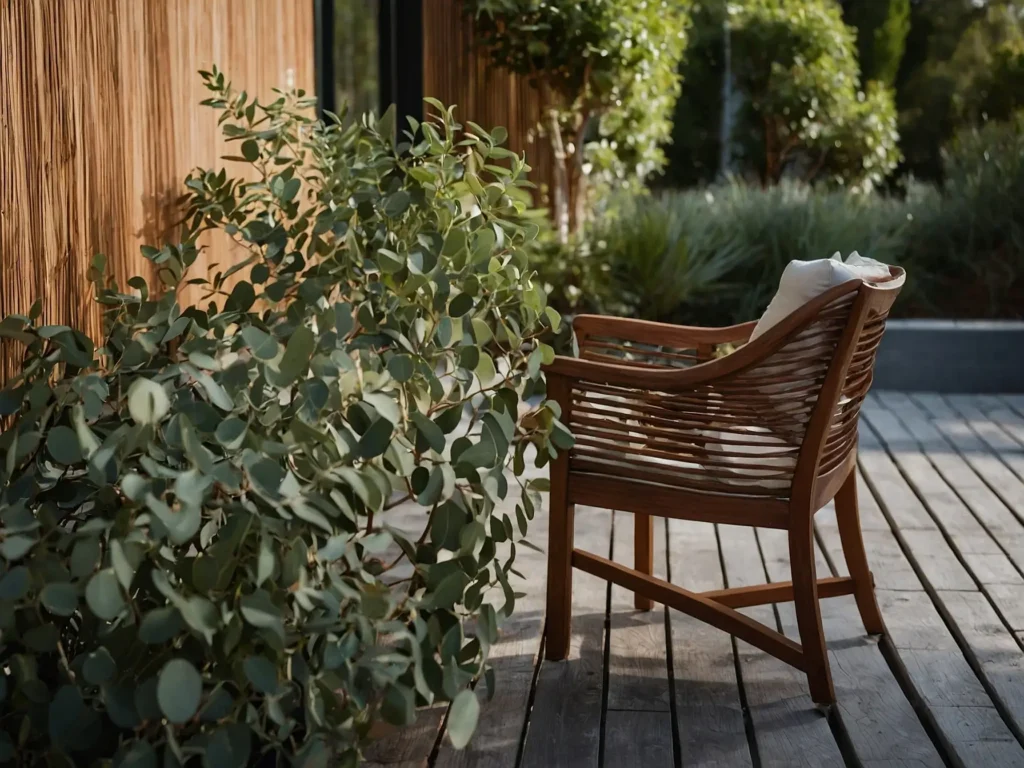
Prized for its weather resistance, eucalyptus is a fast-growing alternative to teak. Oil frequently to maintain its rich coloration.
Shorea
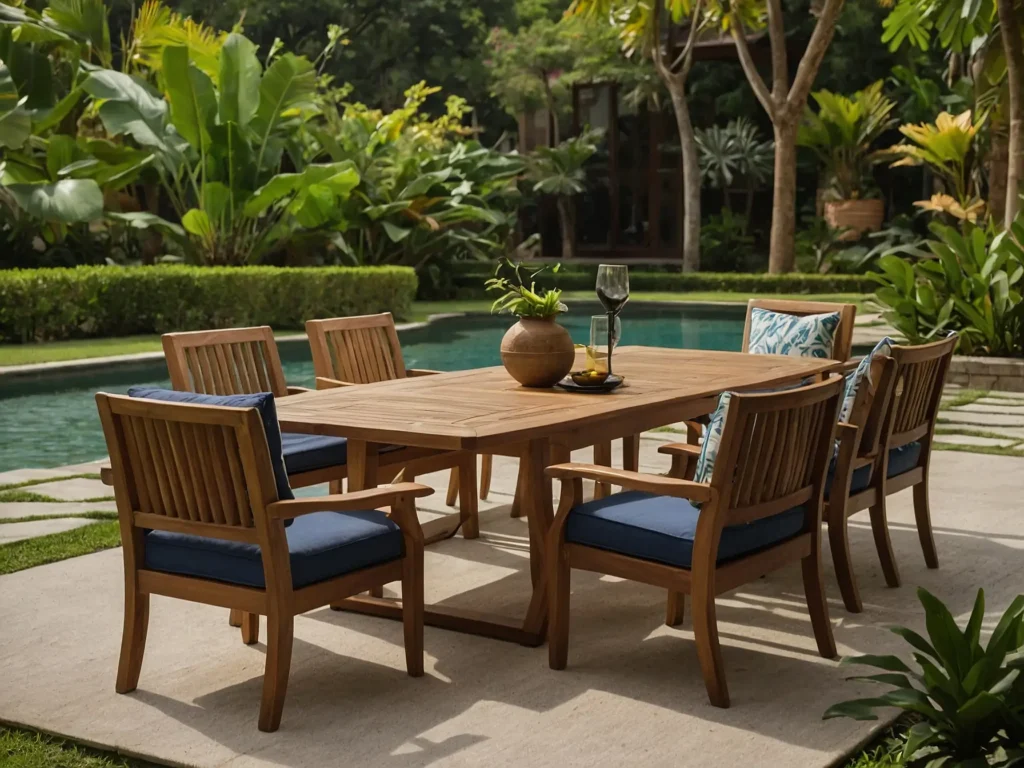
A tropical Southeast Asian hardwood, shorea is sometimes called the “poor man’s teak.” It shares teak’s golden brown color but costs less.
These teak look-alikes retain the aesthetic at a more budget-friendly price point. But none quite match genuine teak’s longevity and cachet.
Durable Exotic Hardwoods
Beyond teak, other exotic hardwoods like ipe and mahogany also make excellent outdoor furnishings. Here’s an overview:
Ipe
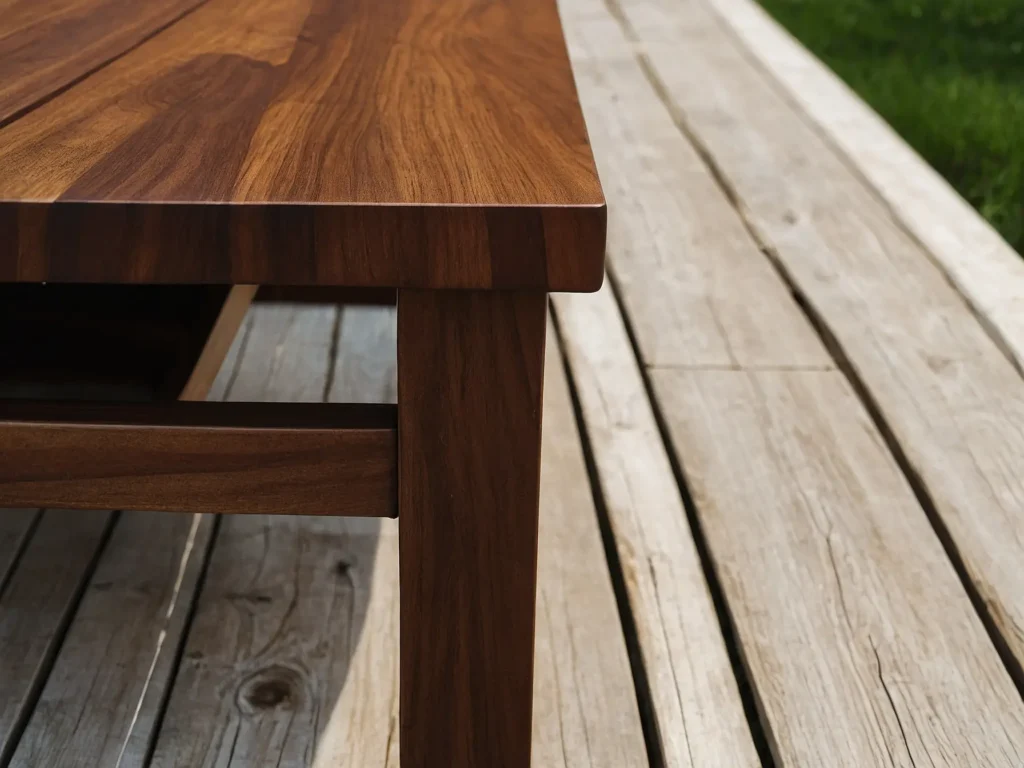
Also called Brazilian walnut, ipe is renowned for its exceptional density and weather resistance. It has a striking visual grain. Ipe is pricier but long-lasting.
Mahogany
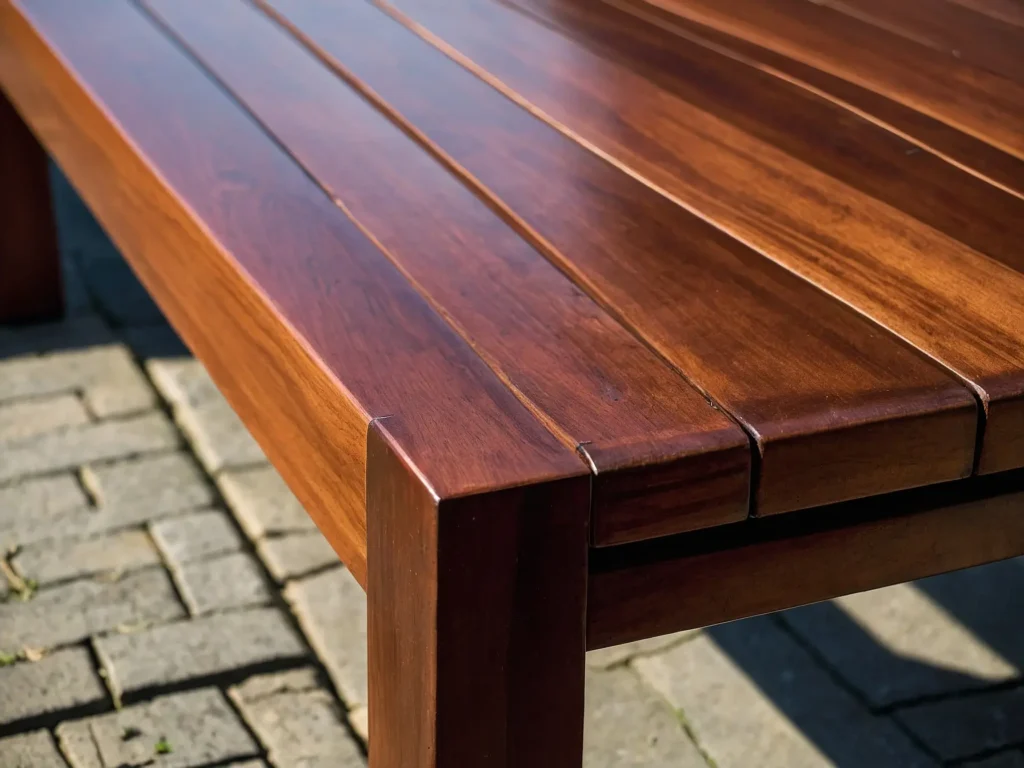
This classic hardwood has a reddish-brown complexion and rich patina. Philippine or Fijian mahogany are the best species for outdoor use. Expect to pay premium prices.
Quality Softwoods – Cedar & Redwood
Softwoods like cedar and redwood are more affordable options for outdoor furniture. Here are their benefits:
Western Red Cedar

With natural rot resistance, cedar makes great patio chairs, tables, and benches. It has a pleasant aroma and ages gracefully to a silvery hue.
Redwood

Redwood is naturally resistant to insects, decay, and moisture. It’s lightweight yet strong. Redwood has a distinctive reddish tone and straight grain.
While not as hard and durable as teak, cedar and redwood resist weathering. They work well in many climates, especially wet regions.
What to Look For in Construction
The quality of construction and hardware impacts durability. Seek out:
- Mortise and tenon joinery – Joints fit precisely together without nails or staples.
- Stainless steel hardware – Resists rust and corrosion. Look for marine-grade stainless steel.
- Thick cuts of wood – Thin cuts can crack over time. Opt for 1-inch thick wood or more.
- Balanced proportions – Clean lines and balanced proportions aid sturdiness.
- Smooth sanded joints – Joints should fit seamlessly together without gaps or splinters.
- Reinforced seating – Well-made furniture has sturdy support under the seat.
- Sunbrella® cushions – Long-lasting, water-resistant, and UV-stable.
Choosing furniture built to last using quality joinery and materials ensures it will hold up outdoors.
Caring for Your Wood Furniture
Hardwoods like teak and ipe will endure outdoors with proper maintenance for decades. Here are some tips:
Weatherproofing
- Apply teak oil or other protective oils yearly to shield from moisture and maintain the wood’s color.
- Waterproofing sealers can be applied for added protection.
- Storing furniture under a cover during winter or severe weather helps preserve it.
Cleaning
- Wash with mild soap and warm water using a soft brush for basic cleaning. Rinse thoroughly.
- For a deep clean, use a wood cleaner formulated for outdoor furniture.
- Allow wood to dry completely after cleaning before applying any protector.
Preventing Damage
- Install furniture leg pads under legs to prevent scratches and rot from ground contact.
- Avoid leaving cushions and pillows outdoors when not in use.
- Inspect furniture periodically for any splinters, cracks, or deterioration.
- Weatherproof hardware like hinges to prevent rust stains.
With proper maintenance and care, your wood will endure for many years of alfresco living.
Eco-Friendly and Sustainable Options
Today more brands offer eco-friendly outdoor furniture made from FSC-certified wood or sustainable materials like recycled plastic or aluminum. Other green options include:
Reclaimed Wood
Furniture crafted from reclaimed barn siding, wine barrels, or salvaged buildings gives new life to old wood. This reduces waste.
Eco-Friendly Woods
Opt for species like bamboo, acacia, and eucalyptus that are renewable and grown on plantations or responsibly managed forests.
Recycled Content
Look for chairs, tables, and loungers containing recycled plastic, aluminum, or eco-resin. This keeps waste out of landfills.
Sunbrella® Fabrics
Made from recycled plastic bottles, these cushions and pillows are sustainably produced. They’re also quick-drying and UV-resistant.
Local Craftsmanship
Support local artisans and woodworkers by purchasing handcrafted furniture from renewable sources.
How Climate Impacts Durability
The climate where you live will affect how well your outdoor furniture endures. Here’s how to choose wood tailored for your local weather:
Hot, Dry Climates
The lack of moisture minimizes decay risks. Teak and shorea excel in arid conditions. Stainless steel hardware avoids corrosion.
Hot, Humid Climates
Frequent rain, storms, and humidity accelerate deterioration. Teak, ipe, and cumaru withstand wet settings well. Opt for weather-resistant fabrics.
Temperate Coastal Regions
Salt air and ocean spray are challenging. Look for dense woods like mahogany paired with rust-proof aluminum frames.
Cold, Snowy Winters
Icy winters can damage more delicate woods. Hearty options like eucalyptus, white oak, and walnut hold up to freezing temperatures
Four-Season Climates
Woods like cedar and cypress handle a range of weather from hot summers to icy winters. All-weather wicker resists cracking and fading. Store furniture in winter.
No matter your climate, always choose furniture with weather-resistant qualities. Teak remains ideal for nearly any setting.
Setting a Budget for Outdoor Furniture
Outdoor furniture spans a vast range of prices. Setting a realistic budget helps narrow your options. Here are typical price ranges for materials:
- Cedar or redwood – $200 to $1,000 for basic patio sets
- Teak – $500 to $5,000+ for high-quality pieces
- Wicker or aluminum – $300 to $1,500 for casual sets
- Recycled plastic – $100 to $800 for affordable, low-maintenance furniture
- Ipe or mahogany – $1,000 to $4,000+ for exotic hardwoods
- Rattan – $800 to $3,000 for all-weather woven pieces
With so many choices, you can find an option to suit your budget. Focus first on durability, then let your budget guide material selection. Quality construction matters more than pure wood type.
Popular Outdoor Furniture Styles
Beyond the wood itself, consider the style of furniture that best suits your space. Popular options include:
Patio Sets
A typical 3-piece patio set includes a sofa, armchair, and coffee table. Sets are commonly available in hardwoods like acacia or painted aluminum.
Dining Sets
A dining table with 4-6 matching chairs is ideal for alfresco meals. Teak tables and eucalyptus chairs are dining set staples.
Chaise Lounges
Perfect for sunbathing, woven chaise lounges often have adjustable backs. Materials like resin wicker, aluminum, and rattan are popular.
Bar Sets
A bar table paired with barstools makes an inviting happy hour spot. Bar sets come in materials like glass, wicker, and weatherproof wood.
Deep Seating
Sectional sofas with ottomans, loveseats, and armchairs encourage lingering. All-weather wicker and recycled resin are common.
Mix and match styles to create your ideal layout. Sectionals and deep seating promote sociability while dining sets are great for entertaining.
Helpful Tips for Buying Outdoor Wood Furniture
- Shop out of season for best selection and pricing. Retailers discount previous year models in fall and winter.
- Examine furniture closely for quality joinery, smooth finishes, and durability. Avoid splinters or nails sticking out.
- Test out comfort by sitting in chairs and loungers. Cushions should be thick and supportive.
- Look for water-resistant cushions and pillows. Polyester fabrics like Sunbrella dry quickly after rain.
- Opt for a neutral color palette to match various settings. But don’t shy away from pops of color either.
- Measure your space carefully and visualize the layout before purchasing. This ensures proper proportions.
- Keep plans in mind. A extendable dining table accommodates guests down the road.
- Choose furniture that reflects your design sensibilities. Traditional, contemporary, or eclectic – opt for your favored aesthetic.
Remembering these tips, you’ll select high-quality, comfortable pieces tailored to your taste and lifestyle.
How to Design a Cohesive Outdoor Living Space
A well-designed outdoor living space should feel like an extension of your indoor decor. Follow these tips:
Define Zones
Create separate zones like a dining area, living room, fire pit hangout, and tranquil reading nook. Arrange furniture accordingly.
Repeat Materials
Using the same materials, like teak dining chairs and coffee tables, provides cohesion. But don’t be afraid to mix metals and fabrics.
Incorporate Greenery
Strategically placed planters with trees, shrubs, and flowering plants help zone spaces and add life.
Overhead Elements
A pergola, vines, market lights, or sun sail helps define spaces while providing shade and visual interest.
Fabrics & Textiles
Layer your space with weather-resistant rugs, throw pillows, curtains, and cushions. Repeat colors and patterns for continuity.
Accessories
Sculptural accents, ceramic garden stools, and objet d’art give personality. Display coffee table books for easy ambiance.
Lighting
Lanterns, post lights, and string lights illuminate zones for safe navigating and ambiance after dusk.
By thoughtfully arranging furniture, adding personality with greenery and accessories, and incorporating fabrics and lighting, you can create an inviting oasis perfect for relaxing and entertaining.
Caring for Your Outdoor Furniture During Winter
The chilly off-season takes a toll. Here are tips to protect your furniture in winter:
- Clean thoroughly before covering or storing furniture. Grime damages the wood surface.
- Oil wood pieces with teak or linseed oil to protect from moisture. Buff any rough spots.
- Check for cracks, splinters, loose bolts, or other issues, and repair before storage.
- Use breathable furniture covers. Avoid plastic sheeting that traps moisture.
- Move furniture to a sheltered area like a garage, shed, or covered patio.
- Raise furnishings on blocks or pallets so it’s not directly on the ground, which can cause rotting.
- Secure rattan, wicker, and fabric pieces in a dry place indoors. Keep out of basements or attics where condensation collects.
- Store cushions, pillows, and fabrics properly. Wash and air dry before placing in a plastic bin or bag.
With proper winterizing, your outdoor furniture will emerge next season looking new. Time invested in maintenance saves money and extends its lifespan significantly.
Best Places to Buy Quality Outdoor Furniture
Where you make your purchase matters. Opt for retailers that specialize in outdoor furniture, like:
Pottery Barn – Extensive selection of wicker, aluminum, wood, and recycled resin pieces with classic appeal.
West Elm – Mix of contemporary, mid-century modern, and tropical styles. Great for modern designs.
Restoration Hardware – Luxury outdoor furniture often made from exotic woods and performance fabrics. Higher price points.
Crate & Barrel – Affordable, minimalist outdoor collections with clean lines. Most are exclusive designs.
Williams Sonoma – Classic look with all-weather wicker and sustainably sourced teak. Also offers custom cushions.
IKEA – Very budget-friendly outdoor pieces. Not the highest quality but great for a first patio set.
Etsy – Unique, handcrafted outdoor furniture from local artisans. Styles range from rustic to mid-century.
Overstock – Massive inventory of discounted patio furniture from various brands. Sort by material to find quality woods.
Wayfair – Everything from inexpensive sets to high-end looks. Helpful filters make it easy to refine your search.
The right retailer provides an extensive selection and stands behind the quality of its outdoor furniture collections.
Key Takeaways for Selecting Outdoor Wood Furniture
- Teak is the gold standard but alternatives like acacia and eucalyptus offer a similar look for less.
- Opt for naturally weather-resistant woods like cedar, teak, and ipé matched to your climate.
- Examine construction quality closely and seek out durable materials like Sunbrella® fabric.
- Set a budget and choose the best quality wood and craftsmanship that fits your price point.
- Shop off-season for deals and refresh tired furniture with weatherproofing each spring.
- Your outdoor wood furniture can endure decades of alfresco living with the right materials and proper care.
Savoring meals, drinks, and conversations outdoors becomes effortless with durable, well-crafted wooden furniture suited for the space and climate. Follow this guide to curate your ideal outdoor oasis – whatever your style, space, and budget may be.

